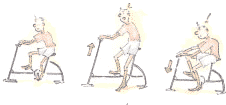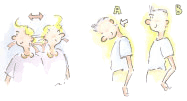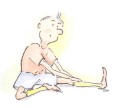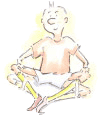Relaxation Techniques - Exercises
Exercise regularly is a good way to reduce stress. Apart from the main exercise, there are warm up and cool down exercises. They are equally important and the intensity of these exercises is lower. These exercises usually stretch all parts of the body. Main exercise consists of walking, taichi, swimming, aqua dynamics, bicycling, jogging and aerobic dance. Regular exercise can reduce stress, maintain physical fitness, prevent heart disease, high blood pressure and improve quality of life.
Warm Up Exercise
|
|
Main
Exercises:
The examples of main exercise are the followings:
- Walking
- Taichi
- Swimming
- Aqua Dynamics
- Bicycling
- Jogging
- Aerobic Exercise
(a) Listen to the music, jump with your legs: lift up and bend your left leg, keep your right leg straight and touch the ground with your toes. Swing your arms from left to right in front of your chest.
 7(a)
7(a)
 7(b)
7(b)
(b) Listen to the music, jump with your legs: lift up and bend your left leg, keep your right leg straight and touch the ground with your toes. Swing your arms up and down on the sides of your body.
We have to adjust our exercise intensity according to our physical fitness level. Avoid exercising the same group of joints or muscles for a long period of time and avoid bending the waist and knees extensively in order to reduce the risk of injuries.
-
Weight Training
(a) Sit on a chair, lift up your right leg, then left leg, for ten to fifteen times. (b) Stand up at the back of a chair, hold on the chair-back, lift up your left leg for ten to fifteen times, and then right leg. (c) Stand up at the back of a chair, hold on the chair-back, lift up and down your heels. (d) Keep your arms parallel to your shoulders, bend your elbow and hold up the dumbbell. Do it step by step from left to right arms. (e) Keep your arms straight, hold up your dumbbells up and down on both sides. 
8(a)
8(b)
8(c)

8(d)
8(e)
Walking is the simplest and most convenient exercise. We can walk in everywhere in our daily life. For examples, before or after our work, we can get off the bus at a bus-stop in advance and take a walk.
While walking, we have to keep our body straight, looking forwards, let your hands swing naturally according to the body movement. It is good to wear sports shoes in order to prevent the stress caused in the backbones and lower parts of the body.
Taichi emphases on the control of breathe and the relaxation of the exercisers. Although the pace of body movement is slow, it can relieve our stress.
While practising taichi, we have to keep our emphasized knees and toes pointing at the same direction because this can prevent the knees from being hurt.
Before swimming, we have to carry out sufficient warm up exercises. While swimming, we have to keep a right position. The benefit of swimming is to let the body supported by water and hence to reduce the opportunities of injuries.
Like swimming, aqua dynamics has the benefit of water support and lower injury opportunities. Apart from this, when we move faster in the water, the resistance power of the water will be larger; when we move slower, the resistance power will be smaller and become a pushing force. Therefore, we have to adjust our pace of movement in the water according to our ability. This can further train our muscles.
The suitable water depth is approximately at our neck when we are standing in the water. It is better at the chest for those who do not know how to swim. To balance our body in the water, we have to put our foots slightly apart, or to hold the handle tightly. If we have companions, we can hold hands in hands and support each other.
When riding a bicycle, we have to adjust the height of the seat.
|
Bicycling
Posture
|
||
|
Seat height
|
||
|
correct
|
too
high
|
too
low
|
 |
||
|
Handlebar
adjustment
|
||
 |
||
|
correct
|
too far backward | too far forward |
It is better to sit on the bicycle and check whether our knees are slightly bent when we have put our feet on the pads.This can avoid hurting the knees. It is not advisable for those who have problems with their knees to have bicycling as their main exercise.
Apart from this, we have to adjust the position of the bicycle handle. The suggested position is that when we are holding the handle, our body is slightly leaning forwards and we feel comfortable.
When jogging, we can use
our mouth to breathe, looking forwards, do not hold our teeth tight.
We can put our hands besides our body, moving forwards and backwards,
not side by side. The angle of the arms is 90![]() C.
We have to relax our fingers, keep our body straight, and keep a comfortable
pace. Use the heels to touch the ground and use the toes to leave the
ground.
C.
We have to relax our fingers, keep our body straight, and keep a comfortable
pace. Use the heels to touch the ground and use the toes to leave the
ground.
Benefits of Exercises
| Physiological aspects: | It can increase blood circulation, oxygen exhaustion and excretion of body waste, and raise body temperature, speed up metabolism. People who often perform exercises have better health, sweet sleep, have greater lungs capacity, strong adaptability and satisfactory lives. |
| Psychological aspects: | It can make people feel comfortable, be more optimistic, have stronger self-image and lower tension. |
Principals of Exercises:
|
Frequency:
|
- | At least three times per week. Daily exercise is recommended. |
|
Duration:
|
- | Twenty to sixty minutes per time, be persistence |
|
Intensity:
|
- |
To determine exercise
intensity, we should know Exercise Heart Rate. The calculation of
exercise Heart Rate is the followings: |
| - |
For example, if Mr. Wong
is 30 years old, his resting heart rate is 70 beats per minute.
Therefore, his exercise heart rate is as follows: |
|
| Perception: | - | Unsuitable and excessive exercise can cause injuries, therefore, exercise intensity has to adjust according to our physical status. |
Dos and Don'ts:
- People who have diabetes, psychological problems, high or low blood pressure, anemia, kidney disease, liver problems, heart diseases, dysfunctional cardiovascular system, obesity and taking drugs, need to seek advice from physicians before starting the exercise program.
- Drink more water before and after exercise, we can drink water during exercise if necessary.
- Use appropriate equipment in order to reduce injuries.
- If we are performing outdoor exercise, we have to wear suitable clothing according to the weather. For example, in summer, we can wear light-colored clothing and cap; in winter, we can wear dark-colored, multi-layered clothing and wool cap, and take them off after our body becomes warm.
- Don't hold our breath during exercises, otherwise, our body cannot be relaxed.











